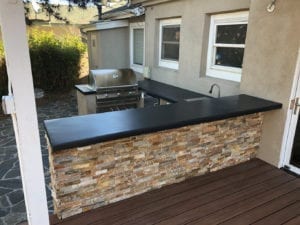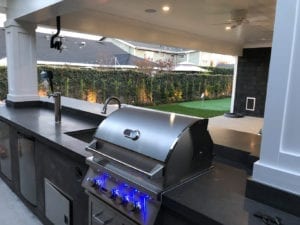An outdoor kitchen can transform your backyard into a culinary oasis and a hub for entertaining guests. With the right planning and execution, you can create a functional and stylish space that combines the joy of cooking with the pleasures of nature.
This guide will walk you through the entire process, from initial planning to the finishing touches, ensuring that you create an outdoor kitchen that suits your needs and enhances your outdoor living experience.
Planning Your Outdoor Kitchen
1. Define Your Goals and Needs
- Consider your cooking habits and the type of meals you want to prepare.
- Determine the size of the kitchen based on your available outdoor space and entertaining needs.
- Decide on the specific features you want, such as a grill, sink, refrigerator, storage, and seating area.
2. Choose the Right Location
- Select a spot that is easily accessible from your indoor kitchen and living areas.
- Ensure proper ventilation and protection from the elements.
- Take advantage of natural views and landscaping to enhance the ambiance.
3. Set a Realistic Budget
- Consider the cost of materials, appliances, and labor.
- Account for additional expenses such as lighting, plumbing, and electrical work.
- Allocate funds for potential upgrades or modifications during the construction process.
4. Research Local Building Regulations
- Check zoning laws and homeowners association guidelines.
- Obtain necessary permits for construction, electrical work, and gas installations.
- Ensure compliance with safety codes and regulations for outdoor structures.
Designing Your Outdoor Kitchen
1. Layout and Structure
- Choose a layout that promotes efficient workflow and convenience.
- Include designated areas for food preparation, cooking, and serving.
- Consider incorporating a countertop for dining and entertaining purposes.
2. Materials and Finishes
- Select durable materials that can withstand outdoor conditions, such as stainless steel, stone, and weather-resistant wood.
- Opt for finishes that complement the aesthetics of your home and landscape.
- Prioritize low-maintenance options that are easy to clean and maintain.
3. Appliances and Fixtures
- Invest in high-quality appliances designed for outdoor use, including a grill, refrigerator, sink, and storage cabinets.
- Choose fixtures that are resistant to rust, corrosion, and water damage.
- Install proper lighting to ensure visibility and ambiance during evening gatherings.
4. Seating and Entertainment
- Incorporate comfortable seating options, such as built-in benches, outdoor dining sets, or bar stools.
- Integrate entertainment features, like a sound system or a mounted TV, to create an inviting atmosphere for socializing and relaxation.

Building Your Outdoor Kitchen
1. Hire Qualified Professionals
- Work with experienced contractors, architects, and designers who specialize in outdoor kitchen construction.
- Ensure that all professionals are licensed and insured to protect yourself from liability.
2. Construct a Solid Foundation
- Prepare the ground surface to create a stable and level foundation for the kitchen structure.
- Consider using concrete, pavers, or natural stone for the flooring to maintain durability and aesthetics.
3. Install Utilities and Infrastructure
- Arrange for proper plumbing and electrical connections to support the kitchen appliances and fixtures.
- Consider the placement of gas lines for the grill and other outdoor cooking equipment.
4. Assemble and Install Appliances
- Follow manufacturer instructions for assembling and installing outdoor appliances.
- Test each appliance to ensure proper functionality and safety.
5. Incorporate Finishing Touches
- Apply weatherproof sealants and coatings to protect the surfaces from water, UV rays, and other outdoor elements.
- Add decorative elements, such as plants, outdoor artwork, and decorative lighting, to enhance the overall aesthetic appeal.
Maintaining Your Outdoor Kitchen
1. Clean Regularly
- Wipe down surfaces and appliances after each use to prevent the buildup of grease, grime, and food residue.
- Use appropriate cleaning products that are safe for outdoor materials and finishes.
2. Perform Seasonal Maintenance
- Inspect the kitchen for any signs of wear and tear, such as cracks, rust, or loose fittings.
- Repair or replace any damaged components to ensure the longevity of your outdoor kitchen.
3. Protect During Harsh Weather
- Cover the kitchen or use protective accessories during inclement weather to prevent damage from rain, snow, or strong winds.
- Store outdoor furniture and accessories in a secure location to prevent deterioration.
4. Upgrade as Needed
- Stay updated with the latest outdoor kitchen trends and technologies to enhance your cooking experience.
- Consider making upgrades or additions based on your evolving culinary preferences and lifestyle.
By following this comprehensive guide, you can create an outdoor kitchen that reflects your personal style and enhances your outdoor living space. With careful planning, thoughtful design, and proper maintenance, your outdoor kitchen will become a beloved extension of your home, where you can savor the joys of cooking and entertaining in the great outdoors.
For further information, check out Top 10 Exterior Design Trends for 2023.





